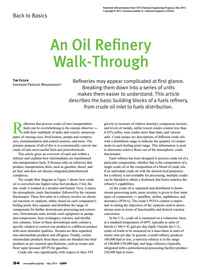 If you’re not in the oil refining business the names of the process units, such as cat crackers, can sound quite exotic. Emerson’s Tim Olsen, a consultant on the refining industry team, wrote a great AIChE Chemical Engineering Progress article, An Oil Refinery Walk-Through. It is written for engineering students and engineers in other industries and describes these refinery units from crude oil inlet to fuels distribution. After reading it, I have a much greater appreciation for the workings of a refinery and what it takes to convert crude oil into what I fuel my car with.
If you’re not in the oil refining business the names of the process units, such as cat crackers, can sound quite exotic. Emerson’s Tim Olsen, a consultant on the refining industry team, wrote a great AIChE Chemical Engineering Progress article, An Oil Refinery Walk-Through. It is written for engineering students and engineers in other industries and describes these refinery units from crude oil inlet to fuels distribution. After reading it, I have a much greater appreciation for the workings of a refinery and what it takes to convert crude oil into what I fuel my car with.
Tim opens with a quick overview description of the flow through the refinery:
First, the raw crude is washed in a desalter and heated. Next, it enters the atmospheric crude fractionator followed by the vacuum fractionator. These first units in a refinery involve no chemical reactions or catalysts; rather, based on each component’s boiling point, they separate and distribute the range of components for further downstream processing and conversion…
Some of these downstream units contain a specific catalyst to convert one product to a different product with more desirable qualities. Streams are then separated into intermediate products and off-gases. Finally, certain intermediate products from these units are blended into final products as per required specifications, such as octane and Reid vapor pressure (RVP) for gasoline.
Tim notes that the incoming crude oil can have a wide range of properties including API gravity (relative density), components (metals, sulfur, salts, etc.) The refinery’s process is typically designed for a specific composition of crude oil. Different types of crude oils can be blended to better match this specific composition.
He highlights four main components of the crude oil after separation and distributed downstream:
…paraffins, olefins, naphthenes, and aromatics (PONA). The crude’s PONA content is important in setting the objectives of the catalysts used in downstream units in terms of functionality and desired reaction conversion.
Tim describes the size of a refinery in terms of the crude oil processed per day. A small refinery processes up 100,000 barrels per day (7 barrels are approximately 1 metric ton, depending on the specific gravity of the crude oil). A mid-size refinery processes up to 250,000 bpd, and large refineries exceed 250,000 bpd production rates.
He addresses the workings of the following units and plant areas: crude desalter, atmospheric crude fractionator, vacuum fractionator, gas concentration unit, fluidized catalytic cracker (FCC), butane isomerization unit and alkylation unit, light naphtha isomerization unit, heavy naphtha reformer and hydrotreater, hydrocracking, delayed coking and asphalt production, amine treating and sulfur recovery blending, and tank farm and distribution.

Source: https://en.wikipedia.org/wiki/Fluid_catalytic_cracking A typical fluid catalytic cracking unit in a petroleum refinery.
Let’s look at the fluidized catalytic cracker (FCC), or cat cracker, which I referenced at the beginning of this post. The technology was developed during World War II to help meet gasoline demands during this period. The process is designed to:
…break—or crack—long chain hydrocarbons such as heavy gas oil into lighter, shorter, naphtha-boiling-range hydrocarbons.
Tim shares with the readers that this is one of the most difficult units in a refinery to operate. The very fine catalyst used in the process flows like a liquid. This fluidized catalyst is mixed with the incoming feed and:
…reacted at high temperatures (900-1,000°F). The cracking reaction is endothermic, and is fueled by the exothermic catalyst-regeneration reaction.
A regenerator burns off coke that ends up on the catalyst as part of the chemical reactions. Downstream of the FCC is the FCC main fractionator column which begins the process of separation and recovery of the cracked hydrocarbons.
I highly recommend the article to give you a great overview of the refining process.
You can connect and interact with refining professionals in the Refining track of the Emerson Exchange 365 community.

